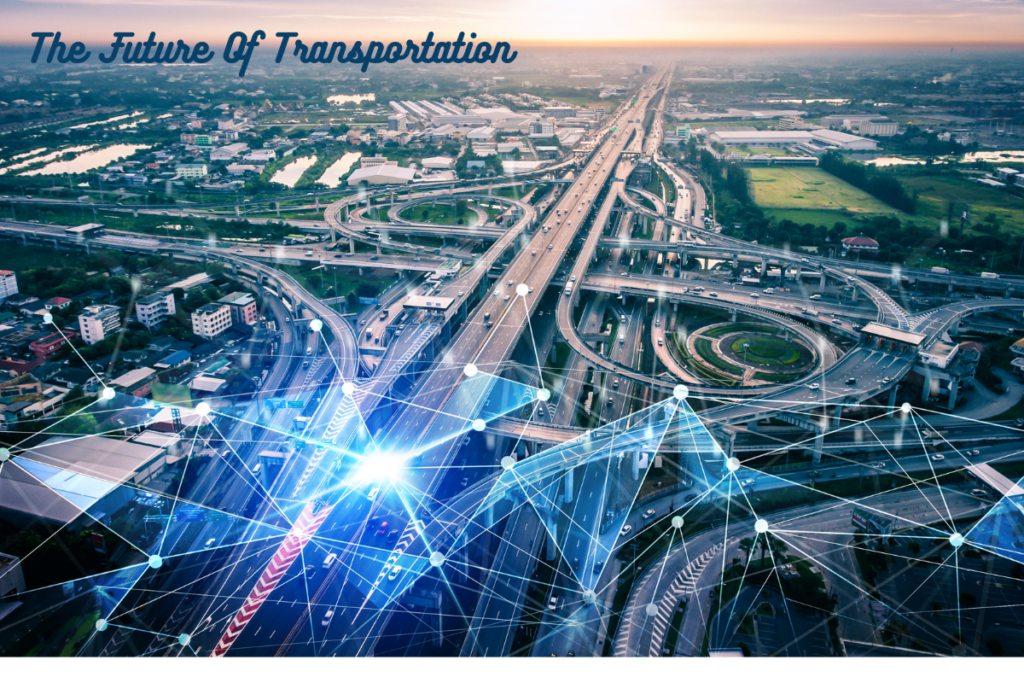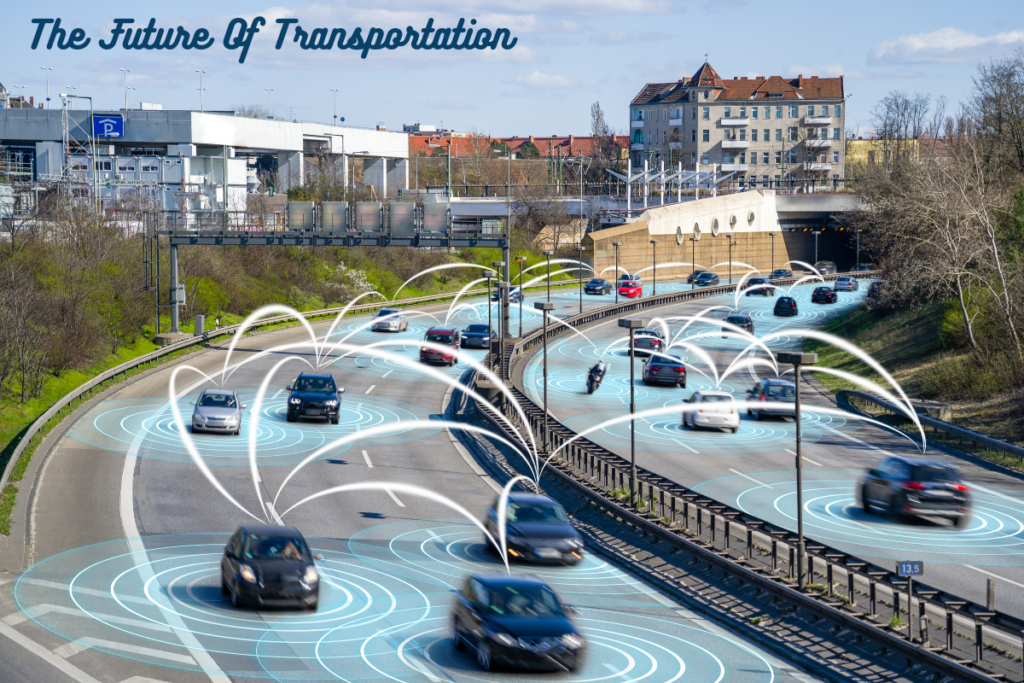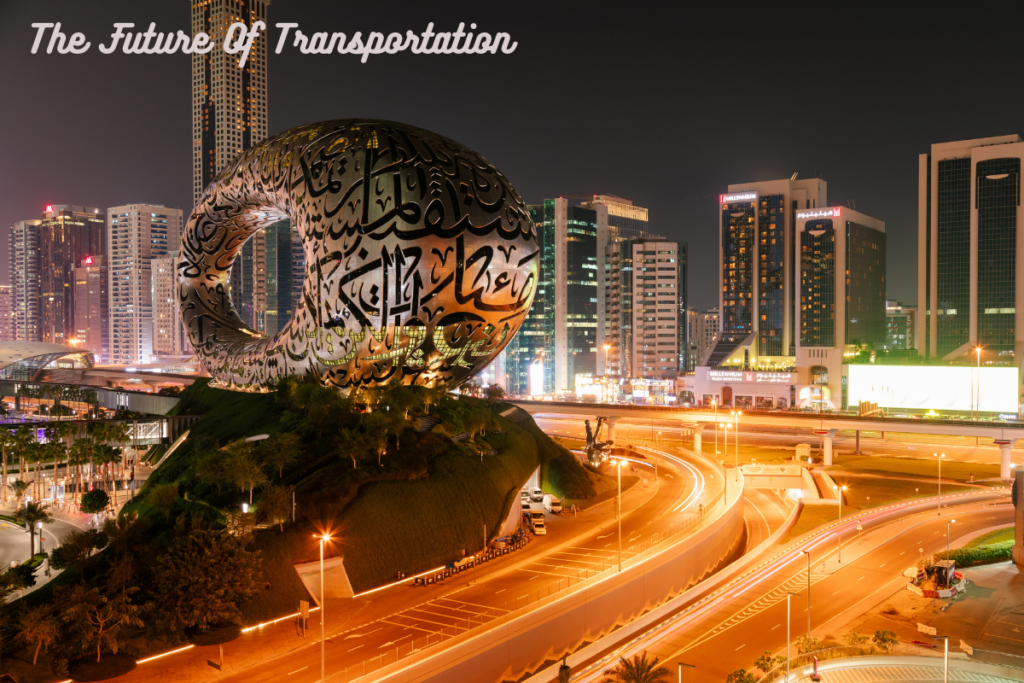Introduction:
“The future of transportation” will change with self-driving automobiles. Autonomous vehicles will change how we travel, commute, and navigate cities as technology advances. This revolutionary change will increase transportation efficiency, urban planning, traffic congestion, and road safety.
In “The Future of Transportation: How Self-Driving Cars Will Shape Our World,” we examine how this invention will affect society, economy, and ecology. This book explores the many ways self-driving cars will transform our environment and what we can expect in the future, from technological advances to legal and ethical issues.

Table of Contents
Technological Advancements in Autonomy:
“The Future of Transportation” depends on AI, sensor, and V2V communication advances. These advances are fueling the autonomous driving revolution, leading to self-driving automobiles.
Technological Advancements in Autonomy:
AI and sensor technology are crucial to “The Future of Transportation.” AI uses sensor data to make real-time driving decisions, keeping cars safe and efficient. The 360-degree vision of Lidar, radar, and cameras detects impediments and ensures safe operation in diverse conditions.
Vehicle-to-vehicle (V2V) communication helps Self driving cars share speed, location, and direction data to prevent collisions, manage traffic, and reduce congestion. These technologies improve road safety and efficiency, enabling a more modern transportation system.
Key developments in autonomous driving software and hardware:
Safety Improvements:
Major advances in autonomous driving software and hardware are increasing self-driving car capabilities. Advanced software algorithms enable real-time data processing and decision-making. Hardware upgrades include faster processors and reliable power sources ensure that automobiles can handle autonomous driving’s needs.
“The Future of Transportation” requires seamless integration of AI, sensor technologies, and V2V communication, together with software and hardware improvements. These innovations are ushering in a safer, more efficient, and more sustainable mobility era.

Self-driving cars will improve road safety in “The Future of Transportation”. People make mistakes that lead to most car crashes, but these self-driving cars could cut that number down by a large amount.
Reducing Accidents Caused by Human Error:
Self-driving cars in “The Future of Transportation” will make decisions using complex algorithms, sensors, and real-time data, eliminating distracted driving, weariness, and intoxicated driving. Self-driving cars respect traffic laws, maintain safe distances, and react swiftly to environmental changes, decreasing crashes.
Impact on Emergency Response and Road Safety:
According to “The Future of Transportation,” autonomous vehicles will increase road safety and emergency response. Automatically detecting and yielding to emergency vehicles speeds up and protects ambulances, fire engines, and police cars. These vehicles can also collect and transmit real-time road data to improve emergency response.
Human error accidents can be reduced to help emergency services deploy resources for proactive safety. This change saves lives and improves emergency services, making streets safer and transportation more reliable.
Urban Planning and Infrastructure :
The “Future of Transportation” involves redesigning cities and building smart infrastructure for autonomous vehicles. Urban design and infrastructure must adapt to optimize the benefits of self-driving cars and enable seamless integration into daily life.
Re-imagining City Layouts to Accommodate Autonomous Vehicles:
According to “The Future of Transportation,” communities must adapt their layouts to accommodate autonomous vehicles. This may require self-driving car lanes, improved road traffic, and more flexible parking structures. Self-driving cars could be able to drop off people and park elsewhere, or they could be able to use traditional parking lots in new ways.
Additionally, urban planners must consider the potential reduction in road space as autonomous vehicles operate precisely and efficiently. Green spaces, pedestrian walkways, and bike pathways could result from this transformation, making cities more habitable and sustainable.
Smart Infrastructure and Connected Traffic Systems:
For autonomous cars, “The Future of Transportation” uses smart infrastructure and integrated traffic systems. To improve traffic flow, sensors, traffic lights connecting with automobiles, and real-time data centers are used. This smart infrastructure streamlines transit to reduce congestion and journey time.
Vehicles will communicate with infrastructure to optimise routes based on traffic conditions for safe and efficient travel. These improvements will improve urban transit safety and efficiency, making travel more reliable. Autonomous vehicles will require major urban design and infrastructural upgrades, creating more efficient, safer, and sustainable cities.
Traffic Congestion and Efficiency:
“The Future of Transportation” uses cutting-edge methods to reduce traffic and boost efficiency. Autonomous vehicles use sophisticated routing and optimal road usage to make travel faster and easier for everyone.

Strategies for Reducing Traffic Bottlenecks through Intelligent Routing:
Smart routing technologies will reduce traffic congestion in “The Future of Transportation” by directing vehicles to the best routes. These systems automatically change routes to avoid congestion using real-time data from traffic sensors, satellite navigation, and linked automobiles. Advanced GPS and communication capabilities allow autonomous vehicles to follow these planned routes without human intervention, improving traffic flow.
The Role of Autonomous Vehicles in Optimizing Road Usage and Decreasing Travel Time:
By improving road efficiency, self-driving automobiles shape “The Future of Transportation”. Advanced control and communication systems allow autonomous vehicles to platoon at higher speeds, alleviating congestion. These cars can take the fastest routes in real time, improving travel times for everyone.
Predictive algorithms in self-driving cars anticipate traffic patterns and change driving behavior to avoid congestion. Using intelligent routing and autonomous vehicle technologies, the goal is to reduce traffic, improve efficiency, and smooth transportation.
Traffic Congestion and Efficiency:
The “Future of Transportation” promises environmental benefits from traffic pattern optimization and electric vehicle adoption. Greener cities and lower pollution are projected from these changes.
The Potential for Reduced Emissions through Optimized Driving Patterns and Increased Electric Vehicle Adoption:
According to “The Future of Transportation,” autonomous vehicles use powerful algorithms to accelerate smoothly, maintain speeds, and follow optimal routes. Since self-driving cars avoid traffic, they use less fuel and emit less pollution. Electric vehicles reduce tailpipe emissions and air pollution, making them essential for the future of transportation. Autonomous and electric vehicles can reduce emissions and improve air quality.
The Future of Transportation Might See Greener Cities with Less Pollution:
According to “The Future of Transportation,” autonomous electric vehicles will make cities greener and healthier. This move reduces automobile emissions, improving city air quality and respiratory health. Electric engines reduce noise, improving urban living conditions.
Parks, pedestrian zones, and green spaces can be added to cities as they alter their infrastructure to support electric autonomous vehicles, improving their beauty and boosting biodiversity and ecological sustainability. These reforms will make cities cleaner, healthier, and more sustainable.
Economic Implications:
“The Future of Transportation” has major economic ramifications, particularly for the employment market and autonomous vehicle ecosystem-created business models. These shifts will alter economies, industries, and jobs.
The Future of Transportation Might See Greener Cities with Less Pollution:
According to “The Future of Transportation,” self-driving cars will change the job landscape, especially driving jobs. Many truckers, taxi drivers, and delivery drivers may lose their employment to automation. Despite job loss, autonomous vehicle design, manufacture, maintenance, and oversight will provide new jobs.
To enter these professions, workers may need AI, robotics, and data analysis training. Logistics and transportation planning will need autonomous fleet managers and optimisers, creating opportunities for job growth and skill development in the developing transportation sector.
New Business Models Emerging from the Autonomous Vehicle Ecosystem:
Automatic cars will change transportation, introducing new business models and services like Mobility-as-a-Service. On-demand transportation will deploy autonomous fleets for subscription-based and ride-hailing services, changing commodities delivery using driverless vehicles and drones.
Data collection and networking can help firms improve services, build smart transportation networks, and personalize products. In the Future of Transportation, specialist corporations will handle self-driving car fleets, causing economic changes, automation in driving occupations, and the creation of novel business models in other industries, creating new opportunities.
Social and Ethical Considerations:
“The Future of Transportation” raises various social and ethical issues that must be addressed to responsibly integrate autonomous vehicles into society. This transformation must address privacy, security, and AI-driven decision-making ethics.
Addressing Privacy and Security Concerns in Autonomous Vehicle Data:
In “The Future of Transportation,” autonomous vehicles will collect data on routes, passengers, and vehicle performance to improve services and safety, but privacy and security problems arise. Data misuse from self-driving cars can compromise privacy, underlining the necessity for anonymization. Regulatory frameworks must protect passenger privacy and govern data.
Cyberattacks on autonomous vehicles could compromise passenger safety and system functioning, so strict cybersecurity safeguards are needed. In “the future of transportation”, autonomous car networks will need strong encryption, regular security updates, and threat detection systems.
Ethical Dilemmas in Decision-Making by AI in Critical Situations:
In “The Future of Transportation,” crucial AI decision-making ethics must be addressed. Autonomous cars face serious ethical challenges requiring quick decisions that could affect human life. Developing algorithms for unavoidable accident scenarios, where AI must choose between potentially damaging consequences, requires ethical frameworks that align AI behavior with society. Another ethical dilemma is defining liability in autonomous vehicle accidents between manufacturers, software developers, and others.
To maintain fairness and impartiality for all populations, self-driving car AI systems must be bias-free. “The future of transportation” requires ethical and societal considerations including autonomous vehicle data privacy and security, as well as ethical AI decision-making in critical scenarios. To overcome these obstacles and ensure the appropriate and fair integration of autonomous vehicles into society, strong rules and guidelines are needed.
Legislation and Policy:
Policy and legislation shape “The Future of Transportation,” especially the integration of autonomous cars into existing transportation infrastructure. A seamless and responsible transition to automated transportation requires government regulations and frameworks for liability, safety, and public acceptance.
The Role of Government Regulations in The Future of Transportation:
In “The Future of Transportation,” government rules shape autonomous vehicle development, testing, and deployment. These legislation will address self-driving car safety, data privacy, insurance, and traffic laws. Governments will need to establish safety certification procedures to ensure autonomous vehicles fulfill tight safety standards before hitting the road, including rigorous testing, reporting protocols, and performance expectations for manufacturers.
For effective regulation and management, autonomous vehicle licensing, registration, and oversight guidelines must define the roles of vehicle owners, operators, and manufacturers and ensure proper identification and tracking within the transportation system.

Developing Frameworks for Liability, Safety Standards, and Public Acceptance:
In “The Future of Transportation,” autonomous vehicle integration requires liability, safety, and public acceptance frameworks. Clear legal rules are needed to assign blame in autonomous vehicle accidents to manufacturers, software developers, owners, and others. Building public trust requires strong safety standards for vehicle design, testing, emergency systems, and cybersecurity.
Self-driving car adoption will be difficult, requiring governments to educate the public, address safety and privacy concerns, and build transparent and responsible regulatory systems. Legislation and policy will shape “the future of transportation” by prioritizing safety, liability frameworks, safety standards, and public acceptance to ensure a smooth and socially responsible transition to a more automated transportation system.
Mobility for All:
The potential of self-driving automobiles to improve accessibility and mobility for everybody, including the elderly and disabled, is intriguing in “The Future of Transportation”. The Future of Transportation uses autonomous vehicle technology to give those with mobility issues more independence.
Enhancing Accessibility for the Elderly and Disabled with Self-Driving Cars:
Self-driving automobiles will make travel safe and convenient for the elderly and disabled in “The Future of Transportation”. These driverless vehicles give mobility-challenged people more independence. People who have trouble moving around can use self-driving cars to get from one place to another, making it easier for them to make friends, get medical care, and enjoy life more generally.
With wheelchair-accessible vehicles, customizable seating, and automated support systems, autonomous vehicles can be adapted to accommodate passengers’ different accessibility demands, guaranteeing that everyone can enjoy self-driving transportation.
The Future of Transportation Includes Increased Mobility Options and Independence:
In “The Future of Transportation,” self-driving cars aspire to change mobility by delivering different options that promote independence and freedom of movement. These autonomous vehicles can reach marginalized populations, isolated areas, and places with little transportation, giving mobility-challenged people new means to travel. Autonomous fleets and Mobility-as-a-Service platforms allow users to travel whenever they want, removing set schedules and public transit lines.
Adaptability allows passengers more control over their journeys, making travel easy. The “future of transportation” envisions empowering people, including the elderly and disabled, with improved accessibility, personalized transport solutions, and expanded mobility choices through self-driving cars, creating a more inclusive and fair transportation system that meets a variety of needs and provides universal access to safe and reliable mobility services.
Public Adoption and Mindset:
Understanding public opinion and trust in autonomous cars is essential for their widespread adoption and successful integration into society in “The Future of Transportation”. “The Future of Transportation” can help people adopt self-driving cars and change how they view transportation by addressing public concerns and promoting trust.
Gauging Public Sentiment and Trust in Autonomous Vehicles:
In “The Future of Transportation,” trust and feeling drive self-driving car adoption. Understanding what influences how people view autonomous vehicles is essential for relieving fears and establishing confidence in this revolutionary technology.
Public view of self-driving cars depends on safety perceptions, and testing, transparency in safety processes, and good track records can assist build trust. For public trust in self-driving cars, strong cybersecurity measures, data protection, and transparent data protection processes are needed to address cybersecurity and data privacy concerns.
Strategies to Promote the Widespread Acceptance of Self-Driving Cars:
In “The Future of Transportation,” public engagement, resolving fears, and emphasizing autonomous vehicle technology’s benefits are essential to promoting mainstream adoption. Dispel misconceptions and raise awareness by explaining what self-driving cars can and cannot do. Communication efforts, public demonstrations, and educational initiatives can promote self-driving car awareness and informed decision-making. Public acceptance of autonomous vehicles requires showing their real-world benefits, such as improved road safety, reduced traffic, and expanded accessibility.
Showing how self-driving cars can improve commutes, transportation efficiency, and environmental effect might change attitudes and increase interest in this revolutionary technology. The success of “The Future of Transportation” depends on public trust in autonomous cars. Understanding public attitude, addressing concerns, and implementing acceptance techniques are crucial to integrating self-driving cars into our transport networks and improving mobility, safety, and efficiency.
Conclusion:
The article “The Future of Transportation: How Self-Driving Cars Will Shape Our World” discusses how self-driving cars will affect transportation. It covers technology, safety, environment, economy, ethics, laws, accessibility, public acceptability, and trust. Transportation will be more efficient, eco-friendly, safe, and accessible with self-driving cars.
Governments, industries, and society must work together to regulate, establish trust, and incorporate self-driving automobiles. This future transportation system balances technology, ethics, and human requirements to provide a connected, safe, and resilient transport environment for future generations and a more sustainable and interconnected society.
People also ask:
Self-driving cars will change urban environments by eliminating the demand for parking, improve traffic flow and safety by lowering accidents, and reduce emissions through efficient driving.
Reduced traffic accidents, increased mobility for the elderly and disabled, decreased emissions, redesigned urban infrastructure, and changes in the economy across a range of businesses are all expected outcomes of driverless automobiles.
Pingback: Steering Towards the Future: The Rise of Self-Driving Cars
Sensors and Alogrithim controlling the Car are more reliable and that can work 24×7.
Pingback: The Self-Driving Car Revolution Feet Up and Let Robots Drive
Pingback: Self-Driving Cars: The Legal and Ethical Considerations
Pingback: From Horsepower to AI Power: Transpor with Self-Driving Cars